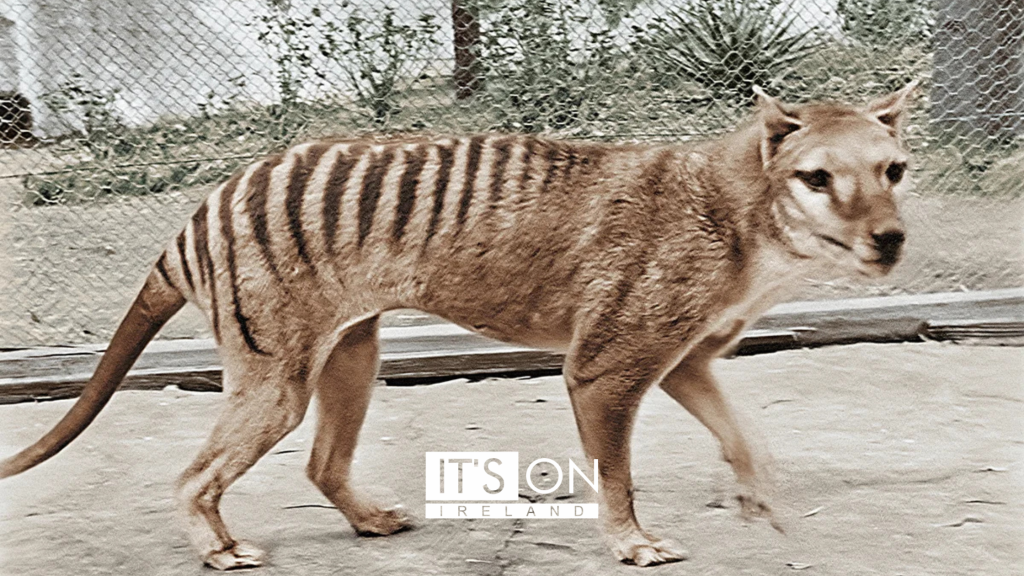Tasmanian Tiger Revival: Scientists Uncover Key Fossil in Stunning De-Extinction Effort
A surprising find in a museum cupboard may hold the key to one of the most ambitious scientific endeavors of our time: bringing the Tasmanian tiger, or thylacine, back from extinction. Scientists have discovered a “pickled” thylacine pup, preserved in a jar for over a century, offering pristine genetic material that could help de-extinct this iconic species. Coupled with advancements in genome sequencing, the possibility of seeing the Tasmanian tiger roam the earth again no longer seems like science fiction.

The Discovery: A Pickled Pup Holds Promise
In an extraordinary turn of events, a thylacine pup, thought to be lost to history, was discovered in a museum’s storage cupboard. The specimen, perfectly preserved in alcohol, offers a rare glimpse into the genetic makeup of the species, which was declared extinct in 1936. Scientists believe that this pup could provide the perfect DNA for sequencing the thylacine genome, a critical step in the de-extinction process.
As Professor Andrew Pask from the University of Melbourne explained, “The quality of this DNA is remarkably high. We’ve never had such a complete specimen to work with before.” This could be the breakthrough researchers have long hoped for in their efforts to bring back the thylacine.
Nearly Complete Genome: A Major Step Toward De-Extinction
In addition to the discovery of the preserved pup, a de-extinction company has made significant progress in sequencing the thylacine genome. They now have a nearly complete genetic blueprint of the Tasmanian tiger, thanks to advanced genome editing technology. With this genome, scientists can fill in the gaps using closely related species, such as the numbat or Tasmanian devil, as genetic templates.
This milestone has brought the goal of de-extinction tantalizingly close. Ben Lamm, CEO of the de-extinction company, said, “With the near-complete genome, we are closer than ever to re-creating a living, breathing thylacine. It’s not just a dream anymore—it’s a reality we’re working toward.”
The Ethical Debate: Should We Bring Back the Tasmanian Tiger?
While the idea of resurrecting an extinct species like the Tasmanian tiger excites many, it has also sparked significant ethical debates. Some scientists and conservationists argue that resources would be better spent on preserving endangered species rather than reviving those that no longer exist. There are concerns about the ecological impact of reintroducing a predator into the wild, especially in ecosystems that have changed dramatically since the thylacine’s extinction.
Others believe that de-extinction could be a powerful tool in conservation. “We’ve lost so many species to human activity—if we have the technology to bring them back, why wouldn’t we?” asked Dr. Erica Sanchez, a conservation biologist. The potential ecological benefits of reintroducing apex predators, like the thylacine, are also being explored.
The Future of De-Extinction
With both scientific and ethical questions surrounding the thylacine project, one thing is clear: de-extinction is no longer just a concept found in science fiction. As genome sequencing technology advances and preserved specimens like the pickled thylacine pup are discovered, the possibility of bringing back extinct species is edging closer to reality.
The success of the Tasmanian tiger project could pave the way for other species to be revived. However, scientists are proceeding with caution, aware of the complexities involved in reintroducing species that have been absent for decades or even centuries. As Professor Pask emphasized, “This is uncharted territory. We’re excited about the possibilities, but we also recognize the responsibility that comes with it.”
A New Era for Conservation?
The combination of a preserved thylacine pup and advanced genome sequencing could lead to the revival of the Tasmanian tiger, a species long believed to be lost forever. While the prospect of bringing back the thylacine is tantalizing, it also raises crucial questions about the ethical and environmental implications of de-extinction. Whether or not the Tasmanian tiger will once again roam the wild, this scientific journey is pushing the boundaries of what is possible in conservation and genetics.
For more stories and insights, visit It’s On
Instagram:@itson.ie
TikTok videos and information:@itson.ie
Share this content:





